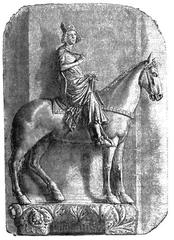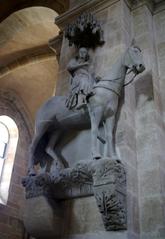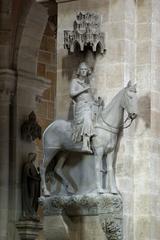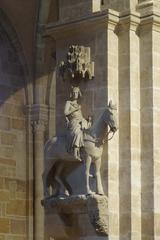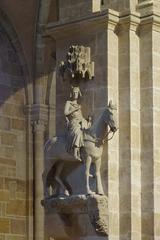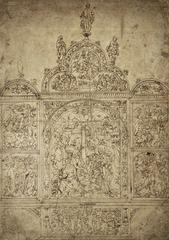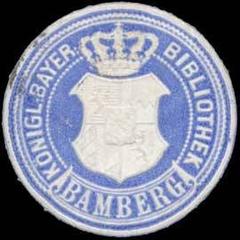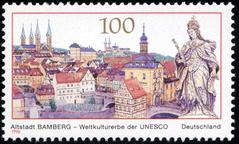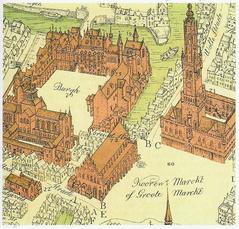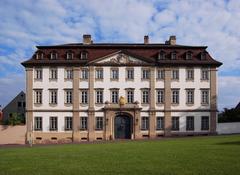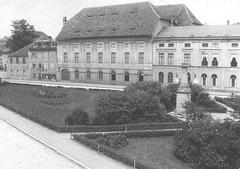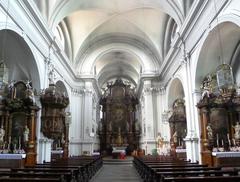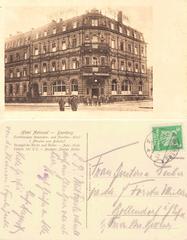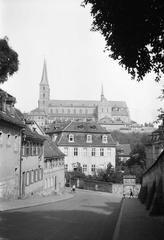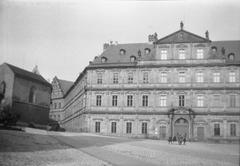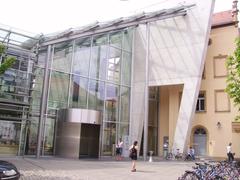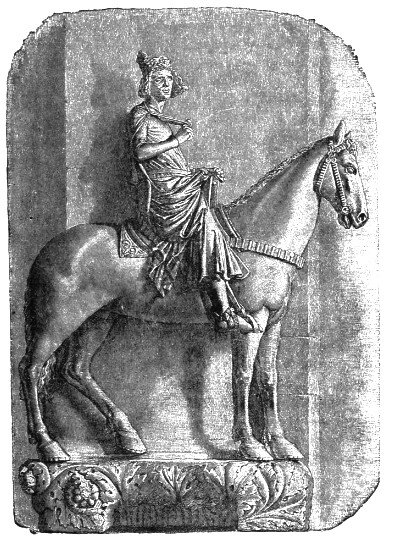
Bamberg Horseman Visiting Hours, Tickets, and Guide to Bamberg Historical Sites
Date: 14/06/2025
Introduction to the Bamberg Horseman and Its Significance
Nestled in the UNESCO-listed heart of Bamberg, Germany, the Bamberg Horseman (Bamberger Reiter) is celebrated as one of Europe’s most remarkable medieval sculptures. Carved from reed sandstone between 1225 and 1237, this life-sized equestrian statue resides within the Bamberg Cathedral (Dom St. Peter und St. Georg), itself renowned for Romanesque and Gothic architectural splendor. The Horseman stands as a symbol of medieval ideals—knighthood, rulership, and Christian virtue—and marks a pivotal revival of monumental equestrian sculpture in the Middle Ages. Its lasting preservation and artistic innovation contribute to Bamberg’s reputation as the “Franconian Rome,” a city of spiritual and political significance.
Visitors find the Bamberg Horseman elevated on a north pillar in the cathedral’s choir, showcased beneath a stone baldachin. This placement allows for multiple viewing angles, revealing the detailed craftsmanship—from the serene, authoritative gaze of the crowned rider to the rare depiction of a shoed horse. While the statue’s precise identity remains the subject of scholarly debate—with theories ranging from Saint Stephen of Hungary to Emperor Henry II or an allegorical chivalric figure—its layered meanings and technical mastery ensure its status as a German cultural icon.
This guide offers essential details for visitors: updated visiting hours, ticketing procedures, guided tour options, accessibility information, and practical tips. It also explores the statue’s historical context, artistic features, and nearby attractions within Bamberg’s UNESCO Old Town. For the latest updates, consult the Bamberg Cathedral official website, Bamberg tourism portal, Wikipedia, and UNESCO.
Contents
- Introduction
- Location and Setting within Bamberg Cathedral
- Physical Description and Materials
- Artistic Features and Style
- Realism and Naturalism
- Symbolism and Iconography
- Technical Innovations
- Condition and Conservation
- Visiting the Bamberg Horseman: Practical Information
- Visiting Hours
- Tickets and Entry
- Accessibility
- Special Events and Quiet Days
- Photography and Etiquette
- Nearby Attractions
- Comparative Significance
- Cultural and Historical Context
- Theories on the Identity of the Bamberg Horseman
- Saintly King Hypothesis
- Emperor Henry II Theory
- Chivalric Ideal and Symbolic Interpretations
- Germanic Hero or Legendary Figure
- Political and Nationalist Appropriations
- Scholarly Debates and Methodological Challenges
- Guided Tours and Visitor Services
- Viewing Tips and Highlights
- Practical Tips for Visitors
- Nearby Attractions and Suggested Itinerary
- Frequently Asked Questions (FAQ)
- Multimedia and Interactive Resources
- Conclusion and Call to Action
Discover Bamberg Cathedral: Visiting Hours, Tickets, and Historical Guide
Bamberg’s Historical Evolution
Founded in the 10th century and elevated as a bishopric by Emperor Henry II in 1007, Bamberg developed as both an imperial and ecclesiastical center. The city’s unique cruciform layout, with Cathedral Hill (Domberg) at its heart, influenced urban planning throughout Central Europe (UNESCO; The Invisible Narad). Bamberg played a key role in the Christianization of the region and flourished during the 12th and 13th centuries, with the cathedral’s Romanesque-Gothic style influencing architecture across Germany and beyond (OVPM). The city’s Enlightenment-era prominence and the preservation of its medieval core have earned it UNESCO World Heritage status since 1993 (UNESCO).
Bamberg Cathedral: Architectural and Spiritual Heart
Consecrated in 1012 and rebuilt in the 13th century after two fires, Bamberg Cathedral features four towers and an imposing blend of Romanesque and Gothic styles (Wikipedia). The cathedral houses the tombs of Henry II and Cunigunde, the tomb of Pope Clement II, and the Bamberg Horseman. Restoration efforts in the 19th and 20th centuries have preserved its medieval character, and the cathedral remains a vibrant hub for worship, cultural events, and tourism (UNESCO; OVPM).
Visiting Bamberg Cathedral: Practical Information
-
Opening Hours:
- April–October: Daily 9:00 AM–6:00 PM
- November–March: Daily 9:00 AM–4:30 PM
- Hours may vary for holidays and special events; always check the official website.
-
Admission:
- Entry is free.
- Guided tours and audio guides (available in multiple languages) require a fee and advance booking.
-
Accessibility:
- Ramps and assistance available; some areas may be challenging for those with limited mobility.
-
Special Events:
- Concerts, festivals, and religious events may affect opening hours and access.
-
Visitor Tips:
- Visit early or on weekdays to avoid crowds.
- Cafés, restaurants, and shops are located around the cathedral square.
Nearby Attractions and Suggested Itinerary
- Old Town Hall (Altes Rathaus): Iconic half-timbered building over the river.
- Neue Residenz: Former palace with rose gardens.
- Diocesan Museum: Ecclesiastical history exhibits.
- Little Venice: Picturesque riverside district.
Combine these sites for a full day exploring Bamberg’s medieval heritage.
The Bamberg Horseman: In-Depth Guide
Location and Setting
The Bamberg Horseman stands on a north choir pillar within Bamberg Cathedral, elevated beneath a stone baldachin, visible from multiple vantage points (Bamberg Cathedral official site).
Physical Description and Materials
This life-sized sandstone statue is approximately 2.7 meters tall, depicting a crowned figure in medieval attire astride a naturalistically rendered horse with horseshoes—the oldest such depiction in sculpture (Waymarking.com).
Artistic Features and Style
-
Realism and Naturalism:
The statue’s anatomical accuracy, flowing cloak, and expressive facial features mark a transition from Romanesque stylization to early Gothic realism (Explorial.com). -
Symbolism and Iconography:
The crowned, unarmed figure is interpreted as a model of Christian kingship, though its exact identity remains debated. -
Technical Innovations:
The three-dimensional carving and depiction of a shoed horse demonstrate advanced artistry for the era (Waymarking.com).
Conservation
Protected inside the cathedral for centuries, the statue is in excellent condition, with ongoing care ensuring its preservation (Bamberg Cathedral official site).
Theories on the Identity of the Bamberg Horseman
-
Saintly King Hypothesis:
Many believe the statue depicts Saint Stephen of Hungary, reflecting Bamberg’s historical ties to Hungary (Wikipedia; Atlas Obscura). -
Emperor Henry II Theory:
Some propose the cathedral founder himself is represented, though direct iconographic evidence is lacking (Meticulous Meanderings). -
Chivalric Ideal:
Other scholars interpret the statue as an allegory of knightly virtues, rather than a specific individual (Explorial). -
Germanic Hero or Legendary Figure:
Theories include legendary rulers or heroes, though these lack strong supporting evidence (Atlas Obscura). -
Political and Nationalist Appropriations:
The statue has been variously appropriated in modern times, notably on the 1920 Weimar Republic 100 Mark banknote and by Nazi propaganda.
Scholarly Debates and Challenges
-
No Contemporary Documentation:
The artist and intended subject remain unknown (Wikipedia). -
Iconographic Ambiguity:
Absence of clear heraldry or inscription allows for manifold interpretations (Explorial). -
Evolving Interpretations:
Scholarship has moved from searching for a specific identity to embracing symbolic and psychological readings (Cambridge Scholars).
Visiting the Bamberg Horseman: Practical Information
-
Opening Hours:
- April–October:
- Mon–Wed: 9:00 AM–6:00 PM
- Thu–Fri: 9:30 AM–6:00 PM
- Sat: 9:00 AM–4:30 PM
- Sun and holidays: 1:00 PM–6:00 PM
- November–March:
- Mon–Wed: 9:00 AM–5:00 PM
- Thu–Fri: 9:30 AM–5:00 PM
- Sat: 9:00 AM–4:30 PM
- Sun and holidays: 1:00 PM–5:00 PM
- Closed during Mass, Quiet Days (e.g., Christmas Eve, Ash Wednesday, Good Friday), and major church celebrations (en.bamberg.info).
- April–October:
-
Admission:
- Entry is free.
- The Domberg ticket (€12) covers entry to all Cathedral Hill museums for one adult and up to three children, valid for one year (en.bamberg.info).
-
Guided Tours:
- Public tours (German/English, advance booking recommended)
- Maximum 20 people per guide
- Book via DoMus visitor service (en.bamberg.info).
-
Accessibility:
- Wheelchair accessible (some uneven flooring; assistance available).
-
Photography:
- Non-flash photography is generally allowed; always verify onsite.
-
Facilities:
- Restrooms, cafés, and restaurants on Cathedral Hill.
Viewing Tips and Highlights
-
Best Times:
Early mornings and late afternoons are quieter.
Avoid Quiet Days and check schedules for organ concerts, which may limit sightseeing. -
Dress Code:
Modest attire (covered shoulders, no hats) in respect of the active place of worship. -
Language:
English tours and materials are often available; confirm when booking.
Frequently Asked Questions (FAQ)
Q: Can I take photos of the Bamberg Horseman?
A: Yes, non-flash photography is allowed unless otherwise posted.
Q: Are guided tours in English available?
A: Yes, but check schedules and book ahead.
Q: Is there an admission fee?
A: Entry is free; guided tours and museum access may require a ticket.
Q: Is the cathedral accessible for wheelchair users?
A: Main entrance and nave are accessible, but some areas may have steps.
Q: When is the cathedral busiest?
A: Weekends and holidays see more visitors; weekdays are quieter.
Visual and Interactive Resources
- High-quality images and virtual tours are available on the official tourism website.
- Interactive maps highlight Cathedral Hill and nearby sites.
Contact and Further Information
-
Visitor Service (DoMus):
- Email: [email protected]
- Phone: +49 (0)951 / 20 85 27 77
- Official Cathedral Website
- Bamberg Tourism Portal
-
Address:
Domplatz 5, 96049 Bamberg, Germany
Summary and Visitor Recommendations
The Bamberg Horseman, a masterpiece of medieval artistry, continues to fascinate visitors with its enigmatic symbolism and technical brilliance. Its prominent setting within Bamberg Cathedral makes it a highlight of any visit to the city. With free entry, accessible tours, and proximity to other historic sites, the Bamberg Horseman is easily included in any exploration of Bamberg’s UNESCO-listed Old Town. To enhance your visit, check opening hours, book tours in advance, and use resources like the Audiala app for interactive guides and timely updates.
For further details, consult the Bamberg Cathedral visitor information, UNESCO World Heritage listing, and Explorial.
References and Further Reading
- Bamberg Cathedral Visiting Hours, Tickets, and Historical Guide to Bamberg’s Iconic UNESCO Site
- Bamberg Horseman: Visiting Hours, Tickets, and Historical Insights
- Discovering the Bamberg Horseman: History, Theories, and Visitor Guide
- Bamberg Horseman Visiting Hours, Tickets & Travel Guide to Bamberg Historical Sites
- Explorial.com: Bamberg Domplatz Guide
- The Invisible Narad: Town of Bamberg
- Organization of World Heritage Cities (OVPM): Bamberg Germany
